Classification and Segmentation of Mining Area Objects in Large-Scale Spares Lidar Point Cloud Using a Novel Rotated Density Network
Abstract
:1. Introduction
1.1. Background
- According to LiDAR specification [17], the point-density defines as the number of points per area where the surface of the earth is sampled. Commonly the point-density is given for one cubic meter (pts/m3). For engineering survey, high, medium, low, and sparse density point cloud is defined as point-density < 2 pts/m3, (2,7] pts/m3, (7,10] pts/m3 and >10 pts/m3, respectively. In order to reduce the computational costs and improve efficiency, many researchers applied the sparse point cloud for classification or segmentation, by using deep learning technology [18,19]. However, applying a sparse point cloud will reduce the amount of data and blur the shape of objects. For large-scale sparse point cloud, with the decrease of the point-density, the shape of the point cloud becomes unclear, the structural feature becomes confused, and the spatially-local correlation becomes difficult to find. Two major constraints to use the sparse point cloud are summarized as: Loose structure: As shown in Figure 1, as the point cloud becomes sparse, the structural features (red dotted line) of the objects become loose. This phenomenon makes it difficult to extract the spatially-local correlation from the sparse point cloud and apply deep learning methods.
- Non-uniform point-density: The distribution of point cloud is not uniform since the point cloud is scanned by different scanning stations. The point cloud data of panoramic mining area was obtained by multi-station stitching. This is done by registering the point cloud of different scanning stations in a unified coordinate system. Because the operating mode of Terrestrial Laser Scanning (TLS) is scanning objects through sensor rotation, the point cloud has a scattering characteristic—the point-density is high when the object is close to the sensor and vice versa. The point cloud of the panoramic mining area is spliced together by multiple scanning stations. For a situation where there are many similar objects in a certain area, such as the grove in Figure 2. When a single TLS station is closer to the object, the density is greater, as shown in Figure 2a; when another TLS station is further away from the object, the density is relatively small, as shown in Figure 2b. Therefore, when stitching together, the non-uniform point-density, the difference in point cloud density of the same object in the overlapping area, will be obvious, as shown in Figure 2c.
1.2. Related Work
1.2.1. Feature-Based Network
1.2.2. Coordinate-Based Network
1.3. Contributions
2. Methodology
2.1. GT-Box Preprocess
2.1.1. Building GT-Boxes
2.1.2. Generating KD-Tree Blocks
2.2. RD-Net
2.2.1. Rotation Unit
2.2.2. Density Unit
2.2.3. The Implementation of RD-Net
2.3. Semantic Analysis with RD-Net+Coordinate-Based Network
3. Materials and Experiments
3.1. Datasets
3.2. Implementation Details
3.3. Design of Experiments
3.3.1. Experiment 1: Performance Evaluation on RD-Net
3.3.2. Experiment 2: Evaluate the Effect of Radius Parameter R
3.3.3. Experiment 3: Performance Evaluation on Different Density Type of Point Cloud
4. Results and Discussion
4.1. Results and Discussion on Experiment 1
4.2. Results and Discussion on Experiment 2
4.3. Results and Discussion on Experiment 3
5. Conclusions
Author Contributions
Funding
Conflicts of Interest
References
- Wang, W.; Sakurada, K.; Kawaguchi, N. Reflectance Intensity Assisted Automatic and Accurate Extrinsic Calibration of 3D LiDAR and Panoramic Camera Using a Printed Chessboard. Remote Sens. 2017, 9, 851. [Google Scholar] [CrossRef] [Green Version]
- Błaszczak-Bąk, W.; Suchocki, C.; Janicka, J.; Dumalski, A.; Duchnowski, R.; Sobieraj-Żłobińska, A. Automatic Threat Detection for Historic Buildings in Dark Places Based on the Modified OptD Method. Isprs Int. J. Geo-Inf. 2020, 9, 123. [Google Scholar] [CrossRef] [Green Version]
- Luo, D.A.; Zhu, G.; Lu, L.; Liao, L.Q. Whole Object Deformation Monitoring Based on 3D Laser Scanning Technology. Bull. Surv. Mapp. 2005, 7, 40–42. [Google Scholar]
- Maxwell, A.E.; Warner, T.A.; Strager, M.P.; Conley, J.F.; Sharp, A.L. Assessing machine-learning algorithms and image-and lidar-derived variables for GEOBIA classification of mining and mine reclamation. Int. J. Remote Sens. 2015, 36, 954–978. [Google Scholar] [CrossRef]
- Yang, J.; Jones, T.; Caspersen, J.; He, Y. Object-based canopy gap segmentation and classification: Quantifying the pros and cons of integrating optical and LiDAR data. Remote Sens. 2015, 7, 15917–15932. [Google Scholar] [CrossRef] [Green Version]
- Fu, K.; Dai, W.; Zhang, Y.; Wang, Z.; Yan, M.; Sun, X. MultiCAM: Multiple Class Activation Mapping for Aircraft Recognition in Remote Sensing Images. Remote Sens. 2019, 11, 544. [Google Scholar] [CrossRef] [Green Version]
- Chen, X.; Kohlmeyer, B.; Stroila, M.; Alwar, N.; Wang, R.; Bach, J. Next generation map making: Geo-referenced ground-level LIDAR point clouds for automatic retro-reflective road feature extraction. In Proceedings of the 17th ACM SIGSPATIAL International Conference on Advances in Geographic Information Systems, Chicago, IL, USA, 5–8 November 2019; pp. 488–491. [Google Scholar]
- Wulder, M.A.; Bater, C.W.; Coops, N.C.; Hilker, T.; White, J.C. The role of LiDAR in sustainable forest management. For. Chron. 2008, 84, 807–826. [Google Scholar] [CrossRef] [Green Version]
- Wang, Y.; Chen, Q.; Liu, L.; Li, X.; Sangaiah, A.K.; Li, K. Systematic Comparison of Power Line Classification Methods from ALS and MLS Point Cloud Data. Remote Sens. 2018, 10, 1222. [Google Scholar] [CrossRef] [Green Version]
- Zhao, H.; Qi, X.; Shen, X.; Shi, J.; Jia, J. Icnet for real-time semantic segmentation on high-resolution images. In Proceedings of the European Conference on Computer Vision, Munich, Germany, 8–14 September 2018; pp. 405–420. [Google Scholar]
- Xu, B.; Jiang, W.; Shan, J.; Zhang, J.; Li, L. Investigation on the weighted ransac approaches for building roof plane segmentation from lidar point clouds. Remote Sens. 2016, 8, 5. [Google Scholar] [CrossRef] [Green Version]
- Li, Y.; Bu, R.; Sun, M.; Wu, W.; Di, X.; Chen, B. PointCNN: Convolution on X-Transformed Points. NeurIPS 2018, 828–838. [Google Scholar] [CrossRef] [Green Version]
- LeCun, Y.; Bengio, Y.; Hinton, G. Deep learning. Nature 2015, 521, 436. [Google Scholar] [CrossRef] [PubMed]
- Zou, X.; Cheng, M.; Wang, C.; Xia, Y.; Li, J. Tree Classification in Complex Forest Point Clouds Based on Deep Learning. IEEE Geosci. Remote Sens. Lett. 2017, 14, 2360–2364. [Google Scholar] [CrossRef]
- Jiang, H.; Hu, X.; Li, K.; Zhang, J.; Gong, J.; Zhang, M. PGA-SiamNet: Pyramid Feature-Based Attention-Guided Siamese Network for Remote Sensing Orthoimagery Building Change Detection. Remote Sens. 2020, 12, 484. [Google Scholar] [CrossRef] [Green Version]
- Yang, J.; Kang, Z. Voxel-based extraction of transmission lines from airborne LiDAR point cloud data. IEEE J. Sel. Top. Appl. Earth Obs. Remote Sens. 2018, 11, 3892–3904. [Google Scholar] [CrossRef]
- Heidemann, H.K. Lidar Base Specification (No. 11-B4); US Geological Survey: Reston, VA, USA, 2012.
- Tatebe, Y.; Deguchi, D.; Kawanishi, Y.; Ide, I.; Murase, H.; Sakai, U. Can we detect pedestrians using low-resolution LIDAR? In Proceedings of the Computer Vision Theory and Applications, Porto, Portugal, 27 February–1 March 2017; pp. 157–164. [Google Scholar]
- Tatebe, Y.; Deguchi, D.; Kawanishi, Y.; Ide, I.; Murase, H.; Sakai, U. Pedestrian detection from sparse point-cloud using 3DCNN. In Proceedings of the 2018 International Workshop on Advanced Image Technology (IWAIT), Chiang Mai, Thailand, 7–9 January 2018; pp. 1–4. [Google Scholar]
- Stein, F.; Medioni, G. Structural indexing: Efficient 3-d object recognition. IEEE Trans. Pattern Anal. Mach. Intell. 1992, 14, 125–145. [Google Scholar] [CrossRef]
- Tuzel, O.; Liu, M.-Y.; Taguchi, Y.; Raghunathan, A. Learning to rank 3d features. In Proceedings of the European Conference on Computer Vision, Zurich, Switzerland, 6–12 September 2014; Proceedings, Part I. pp. 520–535. [Google Scholar]
- Gonzalez, A.; Villalonga, G.; Xu, J.; Vazquez, D.; Amores, J.; Lopez, A. Multiview random forest of local experts combining rgb and lidar data for pedestrian detection. IEEE Intell. Veh. Symp. (IV) 2015, 356–361. [Google Scholar] [CrossRef]
- Chen, X.; Kundu, K.; Zhu, Y.; Berneshawi, A.; Ma, H.; Fidler, S.; Urtasun, R. 3d object proposals for accurate object class detection. Adv. Neural Inf. Process. Syst. (Nips) 2015, 424–432. [Google Scholar]
- Song, S.; Xiao, J. Deep Sliding Shapes for amodal 3D object detection in RGB-D images. IEEE Conf. Comput. Vis. Pattern Recognit. (CVPR) 2016, 808–816. [Google Scholar]
- Chen, X.; Ma, H.; Wan, J.; Li, B.; Xia, T. Multi-view 3D Object Detection Network for Autonomous Driving. IEEE Conf. Comput. Vis. Pattern Recognit. (Cvpr) 2017, 6526–6534. [Google Scholar] [CrossRef] [Green Version]
- Charles, R.Q.; Su, H.; Kaichun, M.; Guibas, L.J. PointNet: Deep Learning on Point Sets for 3D Classification and Segmentation. IEEE Conf. Comput. Vis. Pattern Recognit. (Cvpr) 2017, 77–85. [Google Scholar]
- Qi, C.R.; Yi, L.; Su, H.; Guibas, L.J. Pointnet++: Deep hierarchical feature learning on point sets in a metric space. Adv. Neural Inf. Process. Syst. 2017, 5099–5108. [Google Scholar]
- Cheraghian, A.; Rahman, S.; Petersson, L. Zero-shot learning of 3d point cloud objects. Int. Conf. Mach. Vis. Appl. (Mva). IEEE 2019, 1–6. [Google Scholar] [CrossRef] [Green Version]
- Li, J.; Chen, B.M.; Lee, G.H. So-net: Self-organizing network for point cloud analysis. Proc. Ieee Conf. Comput. Vis. Pattern Recognit. 2018, 9397–9406. [Google Scholar]
- Wang, Y.; Sun, Y.; Liu, Z.; Sarma, S.E.; Bronstein, M.M.; Solomon, J.M. Dynamic graph cnn for learning on point clouds. ACM Trans. Graph. (Tog) 2019, 38, 1–12. [Google Scholar] [CrossRef] [Green Version]
- Cheraghian, A.; Rahman, S.; Petersson, L. Zero-shot learning of 3d point cloud objects. In Proceedings of the 2019 16th International Conference on Machine Vision Applications (MVA), Tokyo, Japan, 27–31 May 2019; pp. 1–6. [Google Scholar]
- Riegler, G.; Ulusoy, A.O.; Geiger, A. OctNet: Learning Deep 3D Representations at High Resolutions. Proc. IEEE Conf. Comput. Vis. Pattern Recognit. (CVPR) 2017, 808–816. [Google Scholar] [CrossRef] [Green Version]
- Maturana, D.; Scherer, S. VoxNet: A 3D Convolutional Neural Network for Real-Time Object Recognition. IEEE/Rsj Int. Conf. Intell. Robot. Syst. (IROS) 2015, 922–928. [Google Scholar]
- Zhou, Y.; Tuzel, O. Voxelnet: End-to-end learning for point cloud based 3d object detection. In Proceedings of the IEEE Conference on Computer Vision and Pattern Recognition (CVPR), Salt Lake City, UT, USA, 18–22 June 2018; pp. 4490–4499. [Google Scholar]
- Wang, D.Z.; Posner, I. Voting for voting in online point cloud object detection. Proc. Robot. Sci. Syst. 2015, 1, 10–15607. [Google Scholar]
- Engelcke, M.; Rao, D.; Wang, D.Z.; Tong, C.H.; Posner, I. Vote3deep: Fast object detection in 3d point clouds using efficient convolutional neural networks. IEEE Int. Conf. Robot. Autom. (ICRA) 2017, 1355–1361. [Google Scholar]
- Lang, A.H.; Vora, S.; Caesar, H.; Zhou, L.; Yang, J.; Beijbom, O. Pointpillars: Fast encoders for object detection from point clouds. In Proceedings of the IEEE Conference on Computer Vision and Pattern Recognition (CVPR), Long Beach, CA, USA, 16–20 June 2019; pp. 12697–12705. [Google Scholar]
- Chen, X.; Ma, H.; Wan, J.; Li, B.; Xia, T. Multi-view 3d object detection network for autonomous driving. In Proceedings of the IEEE Conference on Computer Vision and Pattern Recognition (CVPR), Honolulu, HI, USA, 21–26 July 2017; pp. 1907–1915. [Google Scholar]
- Gonzlez, A.; Vzquez, D.; Lpez, A.M.; Amores, J. Onboard object detection: Multicue, multimodal, and multiview random forest of local experts. IEEE Trans. Cybern. 2017, 47, 3980–3990. [Google Scholar] [CrossRef]
- Enzweiler, M.; Gavrila, D.M. A multilevel mixture-ofexperts framework for pedestrian classification. IEEE Trans. Image Process. 2011, 20, 2967–2979. [Google Scholar] [CrossRef] [Green Version]
- Dai, A.; Chang, A.X.; Savva, M.; Halber, M.; Funkhouser, T.; Nießner, M. Scannet: Richly-annotated 3d reconstructions of indoor scenes. In Proceedings of the IEEE Conference on Computer Vision and Pattern Recognition, Honolulu, HI, USA, 21–26 July 2017; pp. 5828–5839. [Google Scholar]
- Pedregosa, F.; Varoquaux, G.; Gramfort, A.; Michel, V.; Thirion, B.; Grisel, O.; Blondel, M.; Prettenhofer, P.; Weiss, R.; Dubourg, V.; et al. Scikit-learn: Machine learning in Python. J. Mach. Learn. Res. 2011, 12, 2825–2830. [Google Scholar]
- Hackel, T.; Savinov, N.; Ladicky, L.; Wegner, J.D.; Schindler, K.; Pollefeys, M. Semantic3d. net: A new large-scale point cloud classification benchmark. arXiv 2017, arXiv:1704.03847. [Google Scholar]
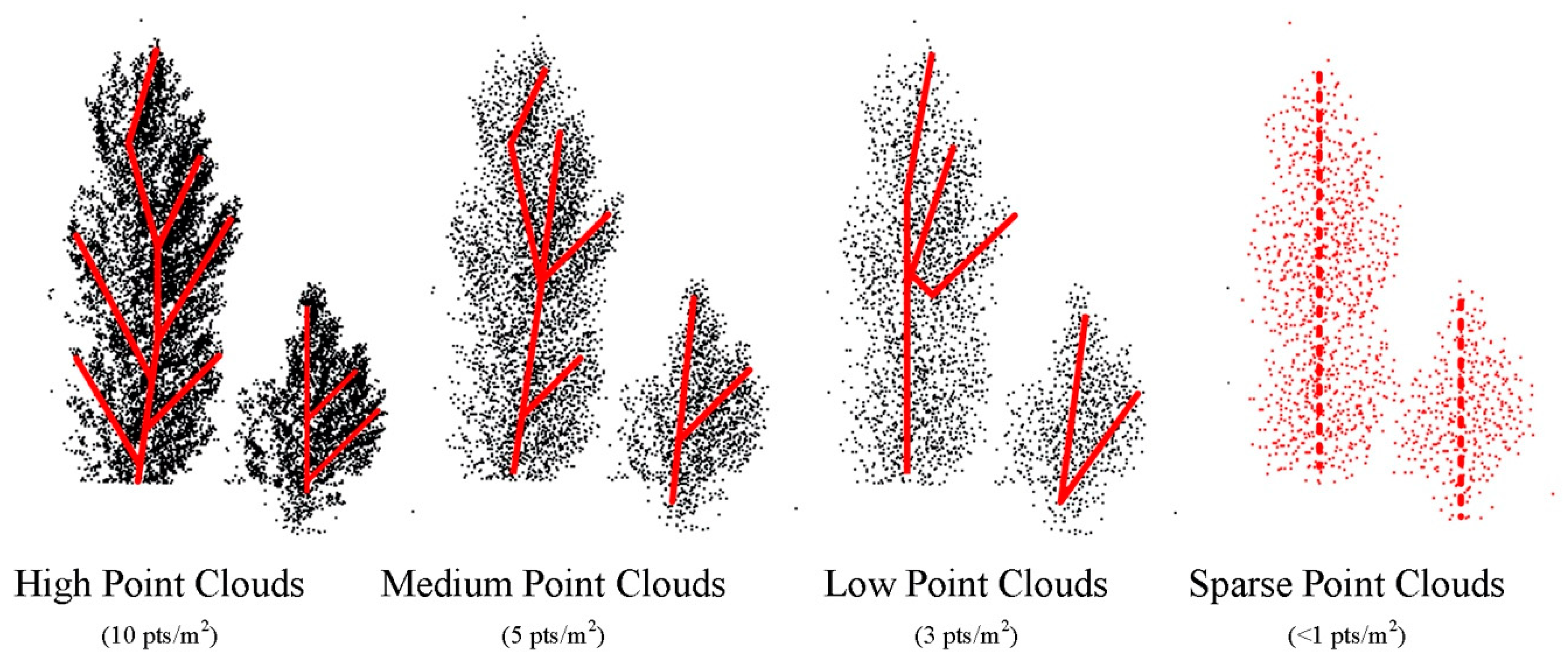

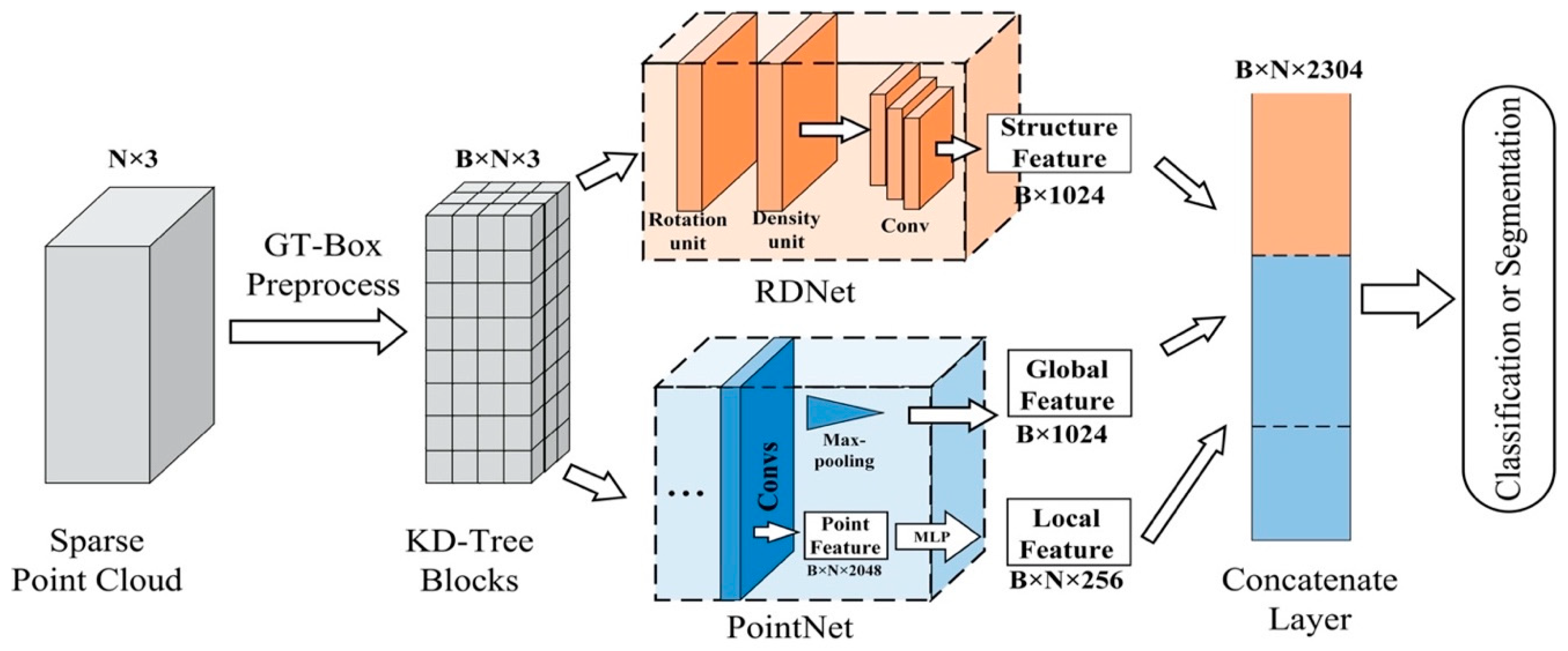
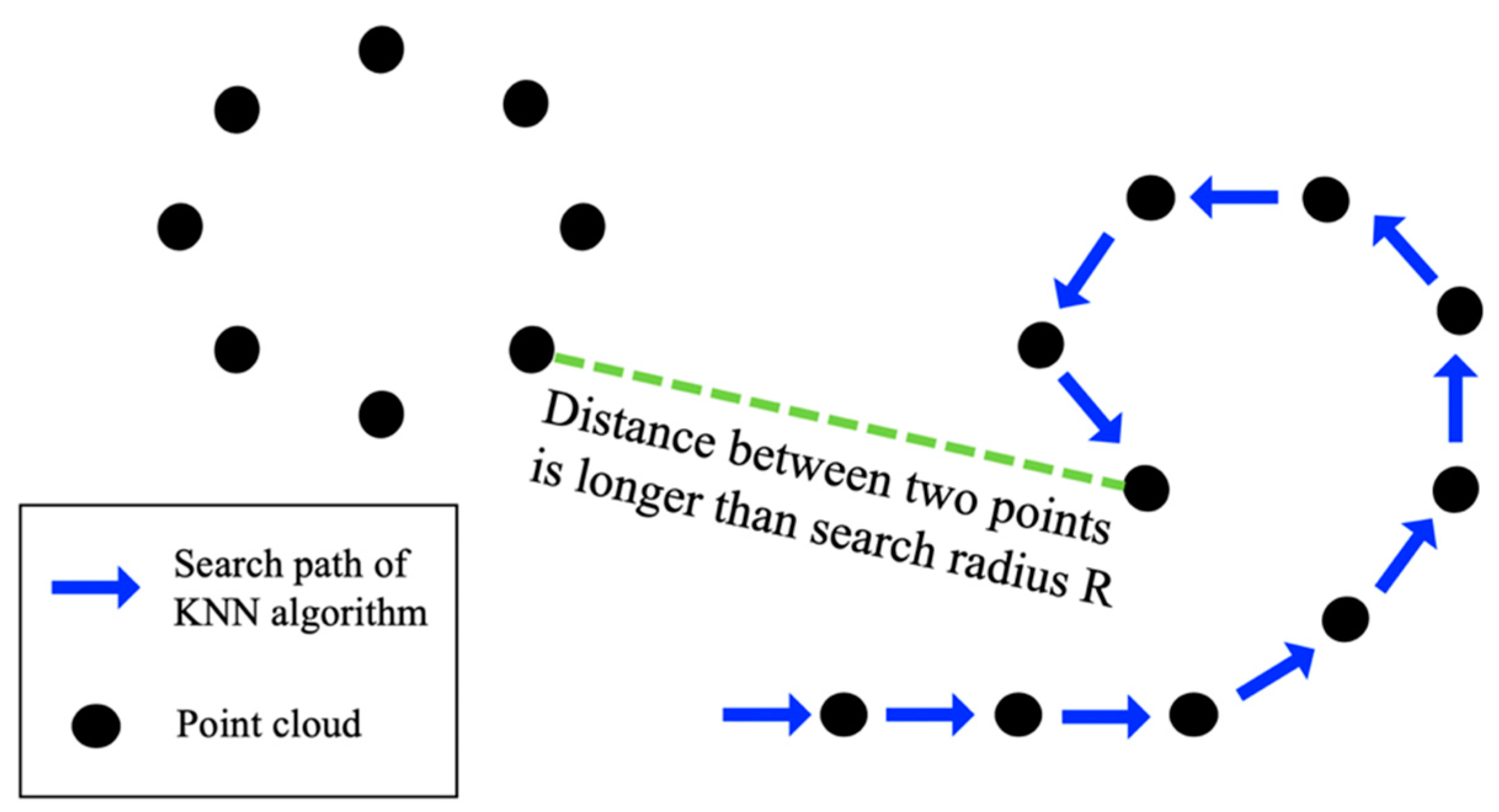

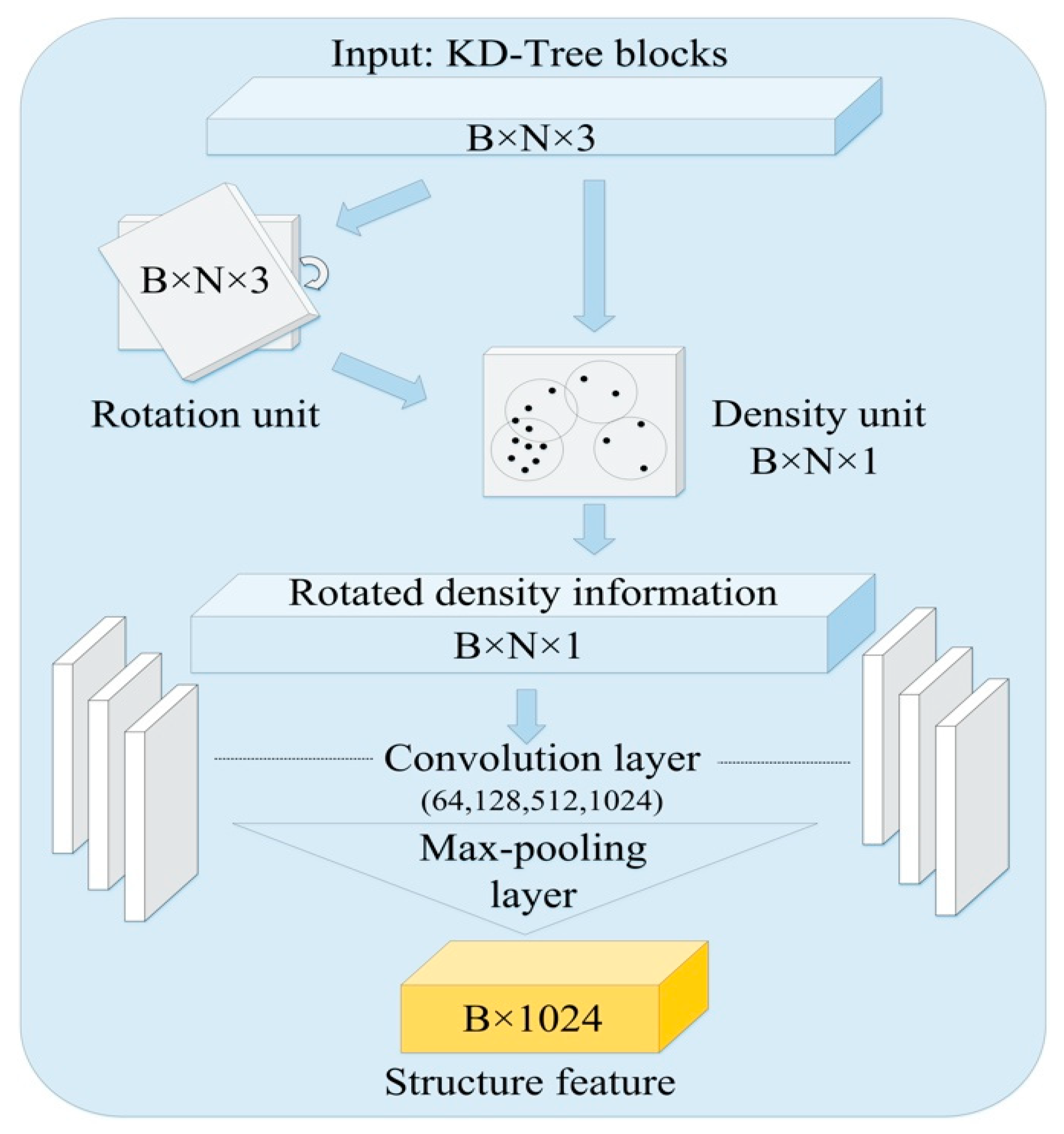
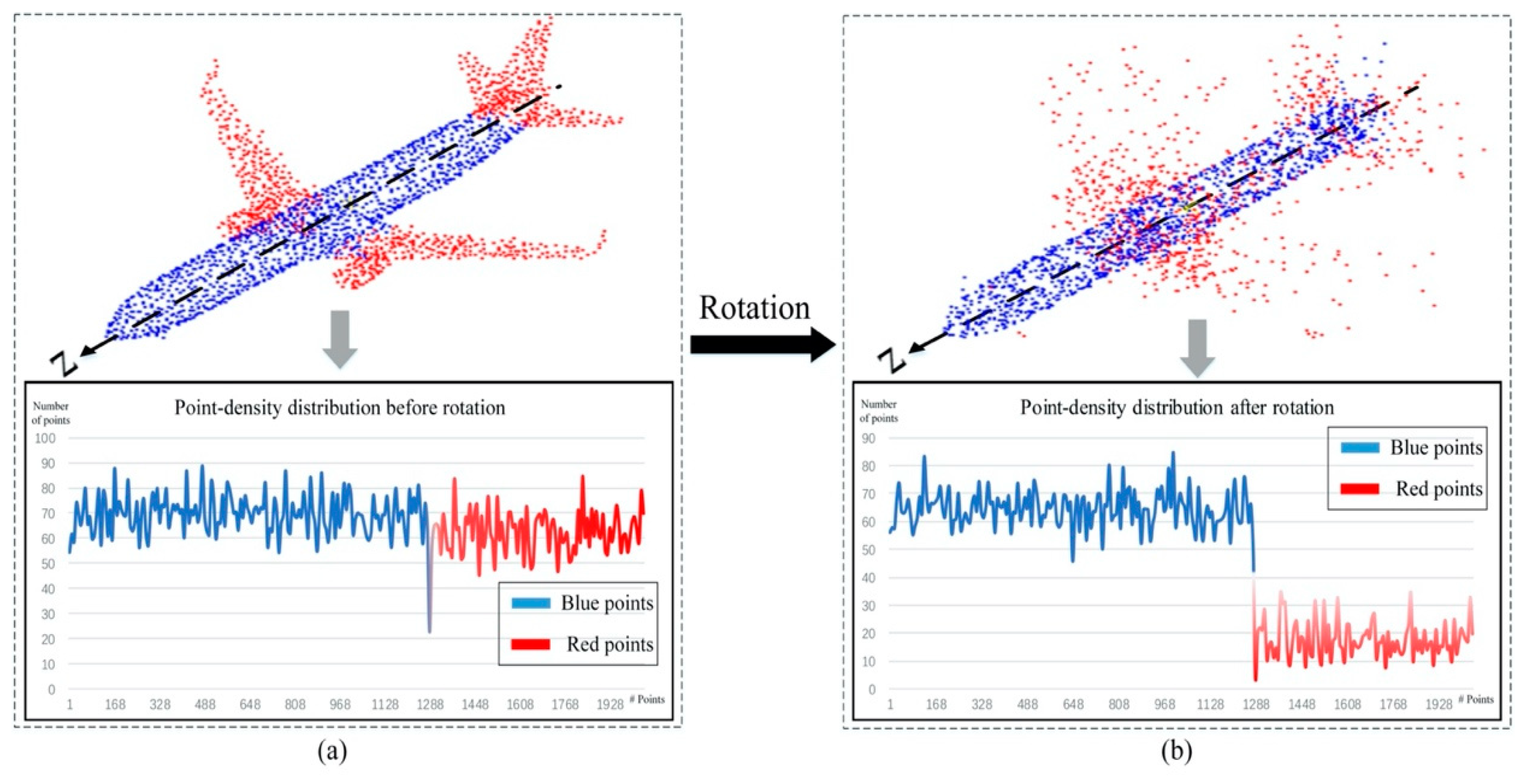
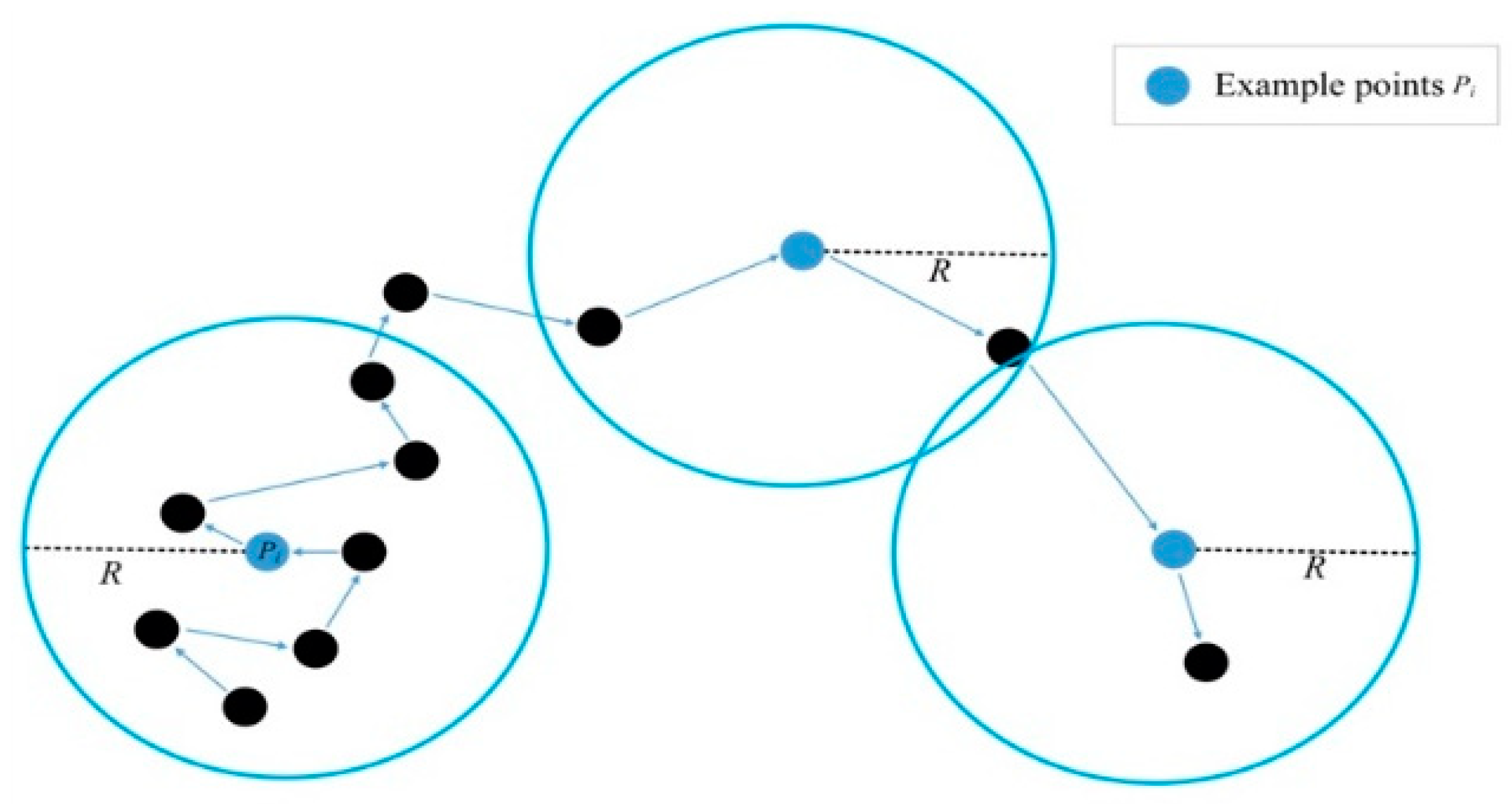
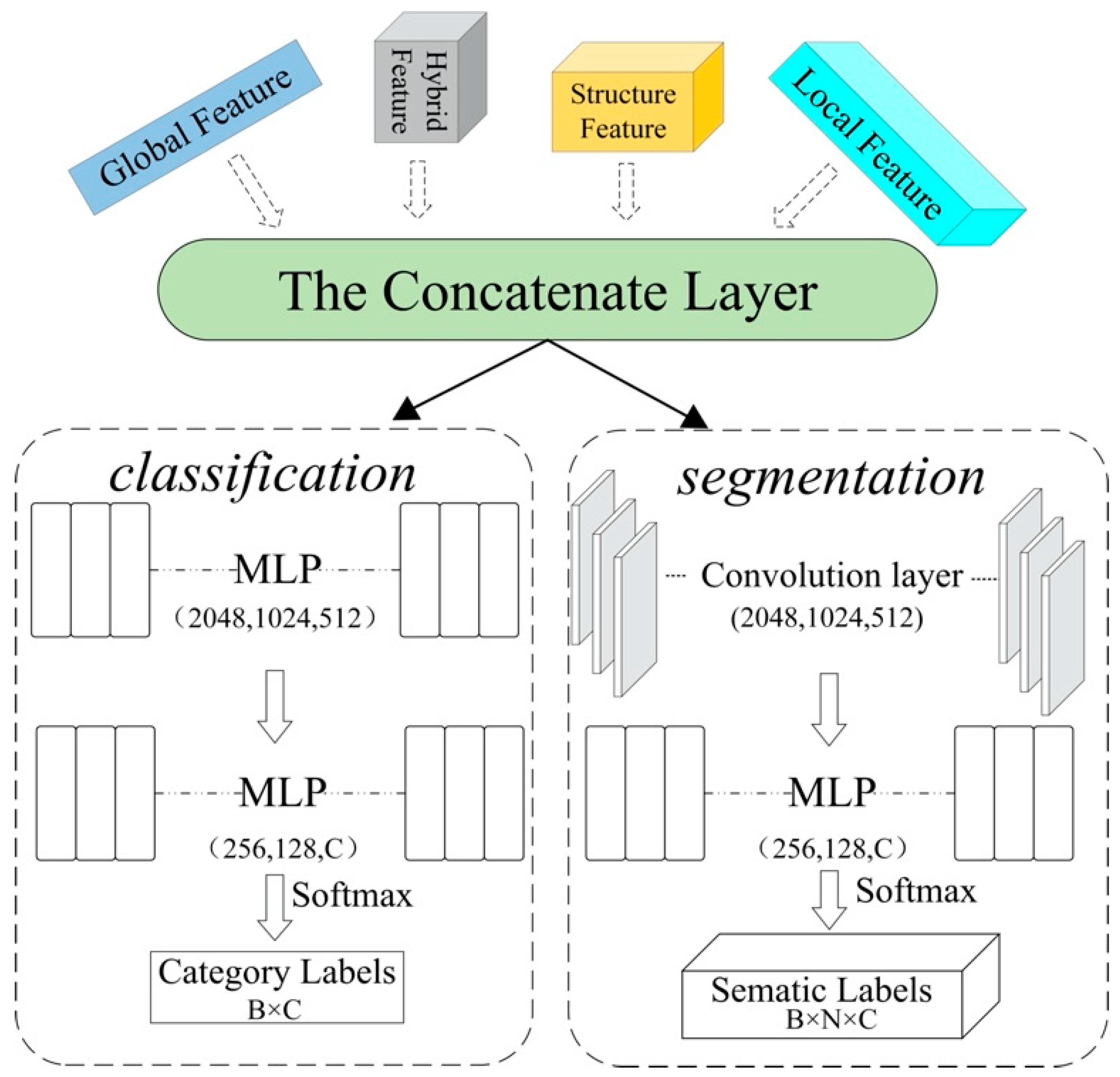

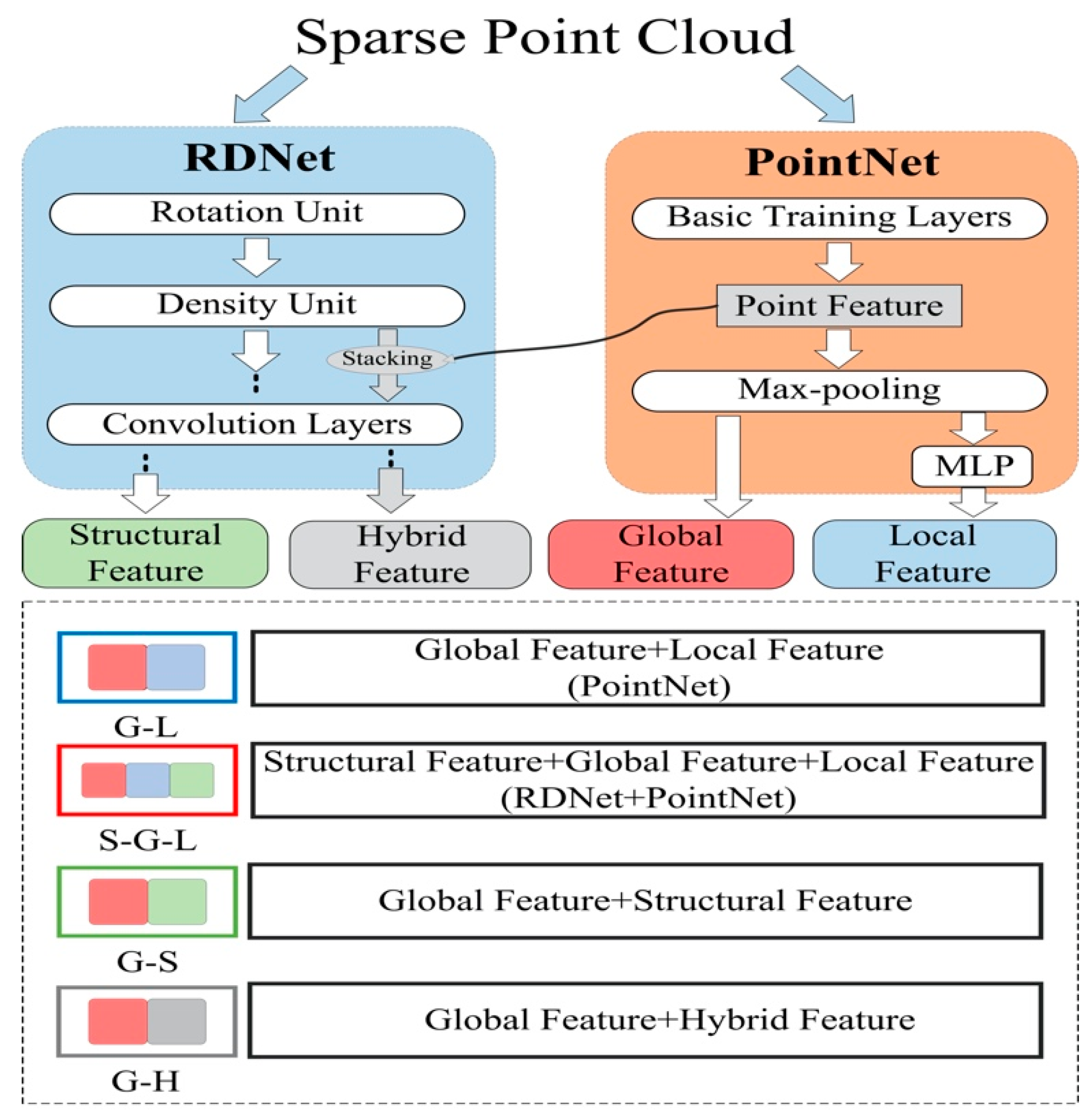


| Scene | Cover Area (Average) | Total Points (Average) | Data Size | File Size | Categories |
|---|---|---|---|---|---|
| Rural (Sematic3D) | 246.8×225.7×64.48 m3 | 45,574 | Sparse (0.8 pts/m3) | 1.7 MB | 8 |
| 232,135 | Low (4.2 pts/m3) | 8.8 MB | 8 | ||
| 398,090 | Medium (7.1 pts/m3) | 15 MB | 8 | ||
| 706,817 | High (>12 pts/m3) | 26.2 MB | 8 | ||
| Mining subsidence basin | 1342.46×1245.2×85.75 m3 | 2,358,642 | Sparse (1.4 pts/m3) | 151.8 MB | 3 |
| 9,672,420 | Low (5.2 pts/m3) | 436.8 MB | 3 | ||
| 14,168,832 | Medium (8.4 pts/m3) | 637.8 MB | 3 | ||
| 16,147,848 | High (>16 pts/m3) | 1064.96MB | 3 |
| Method | Classification accuracy (%) | Mean-IoU (%) | ||
|---|---|---|---|---|
| Mining | Rural | Mining | Rural | |
| PointNet | 90.10 | 81.33 | 80.73 | 42.93 |
| RD-Net+PointNet | 94.06 | 84.20 | 83.41 | 40.65 |
| PointCNN | 80.73 | 82.94 | 66.02 | 51.27 |
| RD-Net+PointCNN | 83.40 | 81.03 | 73.33 | 53.01 |
| RD-Net | 59.93 | - | - | - |
| Combination Mode | Classification Accuracy | Segmentation Mean-IoU | Segmentation Per-accuracy |
|---|---|---|---|
| G-L (PointNet) | 90.1 | 80.7 | 58.9 |
| S-G-L (RD-Net+PointNet) | 94.0 | 83.1 | 70.3 |
| G-S | 92.7 | 70.3 | 50.5 |
| G-H | 89.7 | 65.3 | 68.1 |
| Data Type | Radius R (m) | Classification Accuracy |
|---|---|---|
| Mining subsidence basin (sparse) | 0.2 1 2 | 78.73% 83.24% 94.06% |
| 4 | 78.29% | |
| 6 | 79.03% | |
| Semantic 3D rural (sparse) | 0.23 | 84.32% |
| 0.52 | 79.82% |
| Data size | Running time (second/iteration) | Classification accuracy (%) |
|---|---|---|
| Sparse | 12 | 94.06 |
| Low | 36 | 90.70 |
| Medium | 60 | 94.43 |
| High | 120 | 93.40 |
© 2020 by the authors. Licensee MDPI, Basel, Switzerland. This article is an open access article distributed under the terms and conditions of the Creative Commons Attribution (CC BY) license (http://creativecommons.org/licenses/by/4.0/).
Share and Cite
Yan, Y.; Yan, H.; Guo, J.; Dai, H. Classification and Segmentation of Mining Area Objects in Large-Scale Spares Lidar Point Cloud Using a Novel Rotated Density Network. ISPRS Int. J. Geo-Inf. 2020, 9, 182. https://doi.org/10.3390/ijgi9030182
Yan Y, Yan H, Guo J, Dai H. Classification and Segmentation of Mining Area Objects in Large-Scale Spares Lidar Point Cloud Using a Novel Rotated Density Network. ISPRS International Journal of Geo-Information. 2020; 9(3):182. https://doi.org/10.3390/ijgi9030182
Chicago/Turabian StyleYan, Yueguan, Haixu Yan, Junting Guo, and Huayang Dai. 2020. "Classification and Segmentation of Mining Area Objects in Large-Scale Spares Lidar Point Cloud Using a Novel Rotated Density Network" ISPRS International Journal of Geo-Information 9, no. 3: 182. https://doi.org/10.3390/ijgi9030182
APA StyleYan, Y., Yan, H., Guo, J., & Dai, H. (2020). Classification and Segmentation of Mining Area Objects in Large-Scale Spares Lidar Point Cloud Using a Novel Rotated Density Network. ISPRS International Journal of Geo-Information, 9(3), 182. https://doi.org/10.3390/ijgi9030182





